Potřebujeme váš souhlas k využití jednotlivých dat, aby se vám mimo jiné mohly ukazovat informace týkající se vašich zájmů. Souhlas udělíte kliknutím na tlačítko „OK“.
ASTM D2488-09a
Standard Practice for Description and Identification of Soils (Visual-Manual Procedure) (Includes all amendments And changes 8/18/2017).
Automaticky přeložený název:
Standardní praxe pro popis a identifikaci půd (Visual-Manual Procedure)
NORMA vydána dne 15.6.2009
Informace o normě:
Označení normy: ASTM D2488-09a
Poznámka: NEPLATNÁ
Datum vydání normy: 15.6.2009
Kód zboží: NS-20512
Počet stran: 12
Přibližná hmotnost: 36 g (0.08 liber)
Země: Americká technická norma
Kategorie: Technické normy ASTM
Kategorie - podobné normy:
Zemní práce. Hloubicí práce. Budování základů. Podzemní práce
Anotace textu normy ASTM D2488-09a :
Keywords:
classification, clay, gravel, organic soils, sand, silt, soil classification, soil description, visual classification, Clay, Description/descriptive analysis, Gravel, Identification, Organic soils, Sand, Silt, Soil, Soil classification, Visual examination--soil, Visual-manual procedure, ICS Number Code 93.020 (Earth works. Excavations. Foundation construction. Underground works)
Doplňující informace
| Significance and Use | ||||||||||||||||
|
The descriptive information required in this practice can be used to describe a soil to aid in the evaluation of its significant properties for engineering use. The descriptive information required in this practice should be used to supplement the classification of a soil as determined by Test Method D 2487. This practice may be used in identifying soils using the classification group symbols and names as prescribed in Test Method D 2487. Since the names and symbols used in this practice to identify the soils are the same as those used in Test Method D 2487, it shall be clearly stated in reports and all other appropriate documents, that the classification symbol and name are based on visual-manual procedures. This practice is to be used not only for identification of soils in the field, but also in the office, laboratory, or wherever soil samples are inspected and described. This practice has particular value in grouping similar soil samples so that only a minimum number of laboratory tests need be run for positive soil classification. Note 4—The ability to describe and identify soils correctly is learned more readily under the guidance of experienced personnel, but it may also be acquired systematically by comparing numerical laboratory test results for typical soils of each type with their visual and manual characteristics. When describing and identifying soil samples from a given boring, test pit, or group of borings or pits, it is not necessary to follow all of the procedures in this practice for every sample. Soils which appear to be similar can be grouped together; one sample completely described and identified with the others referred to as similar based on performing only a few of the descriptive and identification procedures described in this practice. This practice may be used in combination with Practice D 4083 when working with frozen soils. Note 5—Notwithstanding the statements on precision and bias contained in this standard: The precision of this test method is dependent on the competence of the personnel performing it and the suitability of the equipment and facilities used. Agencies that meet the criteria of Practice D 3740 are generally considered capable of competent and objective testing. Users of this test method are cautioned that compliance with Practice D 3740 does not in itself assure reliable testing. Reliable testing depends on several factors; Practice D 3740 provides a means for evaluating some of those factors. |
||||||||||||||||
| 1. Scope | ||||||||||||||||
|
1.1 This practice covers procedures for the description of soils for engineering purposes. 1.2 This practice also describes a procedure for identifying soils, at the option of the user, based on the classification system described in Test Method D 2487. The identification is based on visual examination and manual tests. It must be clearly stated in reporting an identification that it is based on visual-manual procedures. 1.2.1 When precise classification of soils for engineering purposes is required, the procedures prescribed in Test Method D 2487 shall be used. 1.2.2 In this practice, the identification portion assigning a group symbol and name is limited to soil particles smaller than 3 in. (75 mm). 1.2.3 The identification portion of this practice is limited to naturally occurring soils (either intact or disturbed). Note 1—This practice may be used as a descriptive system applied to such materials as shale, claystone, shells, crushed rock, etc. (see Appendix X2). 1.3 The descriptive information in this practice may be used with other soil classification systems or for materials other than naturally occurring soils. 1.4 The values stated in inch-pound units are to be regarded as standard. The values given in parentheses are mathematical conversions to SI units that are provided for information only and are not considered standard. 1.5 This standard does not purport to address all of the safety problems, if any, associated with its use. It is the responsibility of the user of this standard to establish appropriate safety and health practices and determine the applicability of regulatory limitations prior to use. For specific precautionary statements see Section 8. 1.6 This practice offers a set of instructions for performing one or more specific operations. This document cannot replace education or experience and should be used in conjunction with professional judgment. Not all aspects of this practice may be applicable in all circumstances. This ASTM standard is not intended to represent or replace the standard of care by which the adequacy of a given professional service must be judged, nor should this document be applied without consideration of a project's many unique aspects. The word “Standard” in the title of this document means only that the document has been approved through the ASTM consensus process. |
||||||||||||||||
| 2. Referenced Documents | ||||||||||||||||
|
Podobné normy:
Historická
1.12.2011
Historická
1.12.2011
Historická
1.7.2012
Historická
1.11.2011
Historická
1.5.2014
Historická
15.1.2010


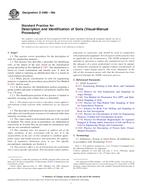
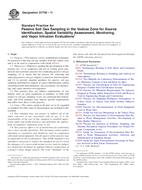 ASTM D7758-11
ASTM D7758-11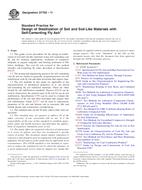 ASTM D7762-11
ASTM D7762-11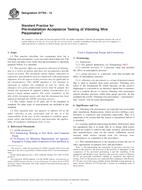 ASTM D7764-12
ASTM D7764-12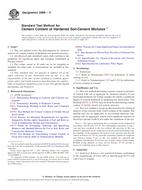 ASTM D806-11
ASTM D806-11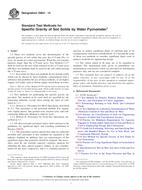 ASTM D854-14
ASTM D854-14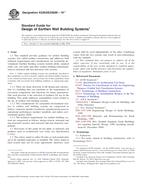 ASTM E2392/E2392M-10..
ASTM E2392/E2392M-10..
 Cookies
Cookies
